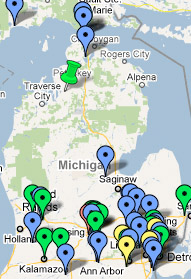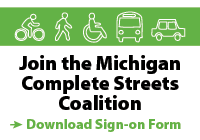NOTE: The following letter was sent to all MDOT employees on August 5, 2010 by Director Steudle. A PDF version of this letter can be downloaded here.

August 5, 2010
What Complete Streets means for MDOT and transportation in Michigan
“Change has a considerable psychological impact on the human mind. To the fearful, it is threatening because it means that things may get worse.
To the hopeful, it is encouraging because things may get better. To the confident, it is inspiring because the challenge exists to make things better.”
– King Whitney Jr., 1967
These words about change are as true today as they were in 1967. On Aug. 1, Gov. Granholm signed into law Complete Streets legislation to advance cooperation and coordination among transportation and local governmental agencies: Public Act 135, which amends Public Act 51 of 1951 governing the expenditure of state transportation funding; and Public Act 134, which amends the Michigan Planning Enabling Act. While it might be tempting to attribute the passage of these bills to pressure from one group or another, it is worth noting that both bills passed the Michigan House and Senate by wide margins: 85-21 and 31-0, respectively.
Here is a summary of the changes to Act 51 under PA 135:
Revisions to Act 51, Section 10(k)
- Requires counties, cities, villages, and MDOT to consult with one another when planning a nonmotorized project affecting a transportation facility that belongs to the other.
- Requires Section 10(k) improvements meet accepted practices or established best practices.
- Requires Act 51 agencies to notify one another when their five-year nonmotorized programs are finalized.
New Act 51 Section 10(p)
- Requires the State Transportation Commission (STC), within two years, to adopt a Complete Streets policy for MDOT, and to develop model Complete Streets policies for use by others.
- Requires state and local agencies to consult and agree on how to address Complete Streets before submitting the Five-Year Program to the STC (exempts anything in an approved multi-year capital plan approved before July 1).
- Allows MDOT to provide technical assistance and coordination to local agencies in the development and implementation of their policies.
- Requires MDOT to share expertise in nonmotorized and multi-modal planning in the development of projects within municipal boundaries (“municipal” refers to townships, counties, cities or villages - so just about anywhere).
- Allows agencies to enter into agreements with one another to provide maintenance for projects constructed to implement a Complete Streets policy.
- Creates a Complete Streets Advisory Council within MDOT, appointed by the governor, to advise the STC and local agencies in the implementation of Complete Streets.
Amendments to the Michigan Planning Enabling Act
- Modifies the definition of “streets” to specifically include all legal users.
- Expands the elements that may be included in a master plan to encompass all transportation systems that move people and goods.
- Specifies that transportation improvements identified in a plan are appropriate to the context of the community and considers all legal users of the public right of way.
- The means for implementing transportation elements of the master plan in cooperation with applicable county road commission or MDOT.
The new laws will influence how we work with virtually every township, county, city, and village in the state. In the coming weeks, I will convene an interdisciplinary work group within MDOT to examine how the new law will affect our processes and resources. If you are asked to participate, I ask that you embrace it as an opportunity to improve how we work with our partners to deliver transportation services in Michigan.
The transportation world is changing. We can face this change fearfully, or with confidence. In my five years as director, we have faced many challenges, adapted to change, and are a better organization for doing so. I am confident we can rise to the challenge of implementing the new Complete Streets law – in letter and spirit – and emerge a stronger organization, and ultimately, a better state.
















8 comments
Comments feed for this article
August 6, 2010 at 7:05 pm
Senate Approves Complete Streets Legislation « Michigan Complete Streets Coalition
[…] MDOT Director Steudle’s letter to employees Possibly related posts: (automatically generated)House Transportation Committee Takes Testimony on Complete Streets BillsComplete Streets Legislation Introduced in Michigan HouseAction Alert: Contact Senate Transportation Committee in Support of HB 6151… Share the Blog Stay Informed Find us on Facebook Follow us on Twitter Get Email Updates Contact Us […]
August 10, 2010 at 5:48 pm
Christina Riddle
Kurt Congratulations! I Have it on good authority that Lucinda is doing the happy dance on her grave since this happened. This decade has not been a complete waste. Good going from the UP where little olde Manistique is putting the complete street resolution for a vote in two weeks.
October 1, 2010 at 3:13 pm
Michigan Transportation Budget Gives Preference to Communities with Complete Streets « Michigan Complete Streets Coalition
[…] Streets policies is an excellent opportunity to encourage more local policies since the recent statewide law only effects the 8% of roads controlled by […]
March 23, 2011 at 4:00 pm
GR City Passes Resolution Favoring Cyclists, Walkers « Michigan Complete Streets Coalition
[…] Granholm signed Complete Streets into law last year for the State of Michigan. Pubic Acts 134 and 135 require the Michigan Department of Transportation and local governments apply the Complete Streets […]
January 20, 2012 at 6:21 pm
Complete Streets Advisory Council to Meet Jan. 25 « Michigan Complete Streets Coalition
[…] 18-member council was appointed in accordance with Public Act 135 of 2010. The group’s role, according to law, is to advise the State Transportation […]
April 19, 2012 at 4:53 pm
Complete Streets Advisory Council to meet April 26 « Michigan Complete Streets Coalition
[…] 18-member council was appointed in accordance with Public Act 135 of 2010. The group’s role, according to law, is to advise the State Transportation […]
July 27, 2012 at 7:52 pm
STC Responds to Public Comment - Approves Strengthened Complete Streets Policy « Michigan Complete Streets Coalition
[…] Public Act 135 of 2010 requires the STC to enact a Complete Streets policy by August 2012. The STC has worked closely with the governor-appointed 18-member Complete Streets Advisory Council on the draft policy. The group’s role, according to law, is to advise the STC, county road commissions and municipalities on Complete Streets policies. Council members represent road and transit agencies, state agencies, walking and biking organizations, and environmental, senior citizens and disabled persons groups. […]
August 15, 2012 at 8:11 pm
Vision for Complete Streets in Michigan « Michigan Complete Streets Coalition
[…] Commission officially adopted a Complete Streets policy on July 26th, 2012, as required by PA 134 and PA 135 of 2010, the Michigan Department of Transportation wasted no time in getting the word out about the good […]